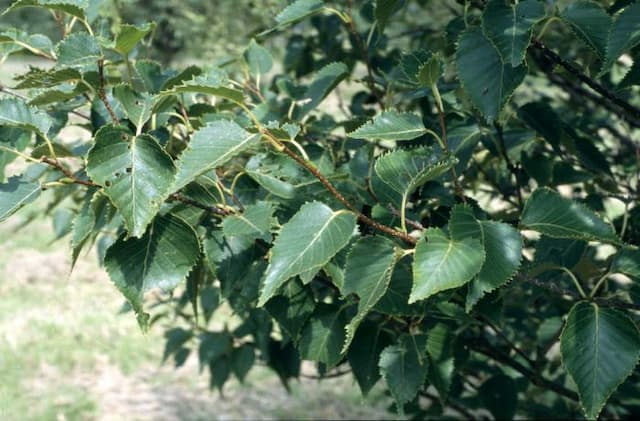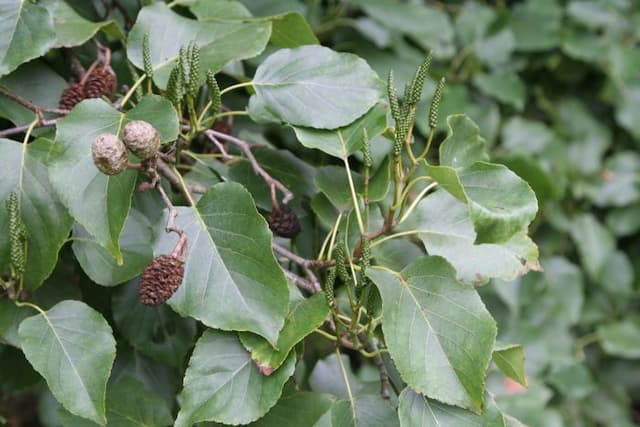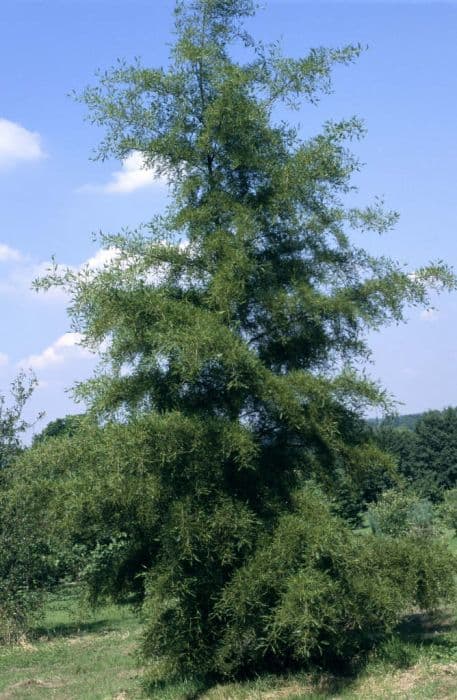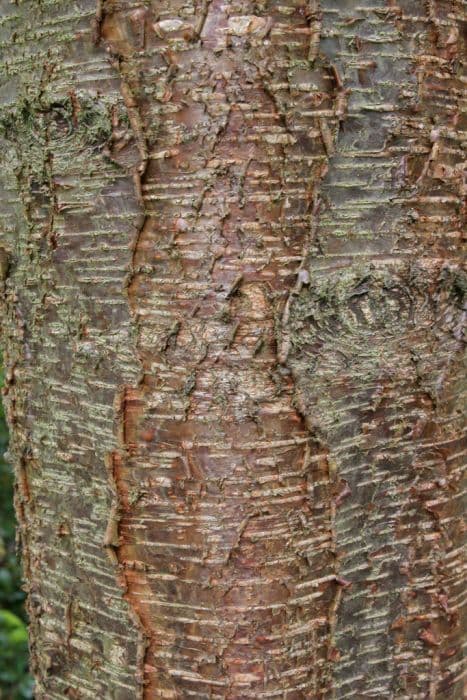Silver Birch Betula pendula subsp. pendula 'Tristis'

ABOUT
The plant commonly known as the Silver Birch 'Tristis' is a captivating and elegant deciduous tree that takes on a weeping form, distinguished by its slender and pendulous branches. The bark of the tree is particularly striking, showcasing a white color that peels off in papery strips, providing a stark contrast against its surrounding landscape. The leaves of 'Tristis' are small and somewhat triangular in shape, displaying a fine serrated edge that adds a delicate texture to the overall appearance. During the growing season, the foliage emerges in a bright green color, transitioning to a vibrant yellow hue as autumn approaches, offering a seasonal display that enriches its visual appeal. Catkins, which are long, slender, and cylindrical flower clusters, appear as the first signs of spring arrive, initially presenting a yellowish-green appearance before turning into a darker shade as they mature. These catkins add a subtle ornamental character to the tree. The combination of the tree's weeping habit, white bark, and seasonal color changes contributes to its popularity as a landscape plant, favored for its unique structure and year-round interest.
About this plant
 Names
NamesFamily
Betulaceae.
Synonyms
Silver Birch, European White Birch, Weeping Birch.
Common names
Betula alba L. 'Tristis', Betula verrucosa Ehrh. 'Tristis', Betula pendula var. pendula 'Tristis'.
 Toxicity
ToxicityTo humans
The Silver Birch is generally not considered toxic to humans. There are no commonly reported symptoms of poisoning from ingesting parts of this plant, as it is not known to have harmful effects.
To pets
Similar to its effects on humans, the Silver Birch is generally considered non-toxic to pets. Ingesting parts of this plant typically does not lead to poisoning or produce harmful symptoms in animals.
 Characteristics
CharacteristicsLife cycle
Perennials
Foliage type
Deciduous
Color of leaves
Green
Height
40 feet (12 meters)
Spread
20 feet (6 meters)
Plant type
Tree
Hardiness zones
2
Native area
Europe
Benefits
 General Benefits
General Benefits- Aesthetic Appeal: The Silver Birch 'Tristis' has a graceful, weeping habit and delicate foliage that adds visual interest to landscapes.
- Wildlife Habitat: It provides food and shelter for various bird species, as well as being a host plant for butterfly and moth larvae.
- Soil Improvement: The tree contributes to soil health by fixing nitrogen and improving soil structure with its root system.
- Shade and Cooling: Its canopy offers shade, which can lower surrounding temperatures and provide relief on hot days.
- Erosion Control: The root system helps to stabilize the soil and prevent erosion, particularly on slopes and banks.
- Adaptability: Silver Birch 'Tristis' is known for its ability to thrive in a variety of soil types, including poor soils.
- Seasonal Interest: It displays seasonal changes, with bright green leaves in spring, yellow foliage in autumn, and attractive bark in winter.
 Medical Properties
Medical Properties- Anti-inflammatory: The leaves and bark of Silver Birch may contain compounds that help reduce inflammation.
- Diuretic: Traditionally, it has been used to promote the production of urine, which can help in the elimination of waste from the body.
- Antiseptic: Birches have been used for their antiseptic properties to help prevent infection.
- Detoxifying: Silver Birch sap has been consumed historically for its purifying and detoxifying effects.
 Air-purifying Qualities
Air-purifying QualitiesThis plant is not specifically known for air purifying qualities.
 Other Uses
Other Uses- Birch twigs are traditionally used in brooms and brushes due to their toughness and resilience.
- The wood of the Silver Birch can be used as high-quality firewood that burns with a strong, bright flame producing significant heat.
- The bark of the Silver Birch can be crafted into durable and water-resistant containers, like baskets and boxes.
- Dyes extracted from the leaves, bark, and twigs of the Silver Birch provide varying colors for textiles and leather work.
- Due to its interesting weeping form, Silver Birch is often used as an inspiration or model in art and photography, emphasizing form and texture in natural subjects.
- Silver Birch sap can be tapped in the early spring and used to make birch sap wine, a traditional alcoholic beverage in some countries.
- Woodworkers value Silver Birch timber for its fine grain, using it to create veneers and intricate decorative wooden items.
- The culturally significant practice of birching—using birch twigs to make a disciplinary instrument—derives from the durability and availability of these twigs.
- Birch wood is sometimes used in the smoking process of foods like meats and cheeses to impart a distinctive flavor.
- In landscaping, Silver Birch's elegant, pendulous branches are often integrated into garden designs for their visual appeal throughout the year, especially in winter when the foliage is absent.
Interesting Facts
 Feng Shui
Feng ShuiThe Silver Birch is not used in Feng Shui practice.
 Zodiac Sign Compitability
Zodiac Sign CompitabilityThe Silver Birch is not used in astrology practice.
 Plant Symbolism
Plant Symbolism- Purity and Cleansing: The common name for Betula pendula subsp. pendula 'Tristis' is Silver Birch. Silver Birch trees are often associated with purity due to their bright white bark and the way they appear to shine in the landscape, symbolizing a fresh start or cleansing away of the old.
- New Beginnings: In various cultures, birch trees represent new beginnings and renewal. This is partly because they are one of the first trees to leaf in the spring, signaling the end of winter and the beginning of a new growth cycle.
- Protection: In folklore, Birch trees are thought to ward off evil and negativity. People used to hang birch branches over their doors to protect their homes from harm.
- Youth and Vitality: With its elegant, slender form and youthful look, the Silver Birch symbolizes youth and energy. It often stands as a metaphor for the vigor and the exuberance associated with youth.
- Adaptability and Resilience: As birch trees can thrive in various climates and are often one of the first species to grow back after a forest has been cleared or burned, they symbolize adaptability and the ability to bounce back from adversity.
 Water
WaterThe Weeping Birch (Betula pendula 'Tristis') prefers consistent moisture, particularly in the growing season. Aim to water young trees deeply once or twice a week, making sure the soil is moist but not waterlogged. Mature trees typically require less frequent watering. Provide about 1 to 2 gallons per watering session, depending on weather conditions. In times of drought or extreme heat, increase watering frequency to maintain soil moisture.
 Light
LightWeeping Birch flourishes in full sun, where it can receive at least six hours of direct sunlight daily. Planting it in an unobstructed area that provides ample sunlight will ensure optimal growth and health.
 Temperature
TemperatureThe Weeping Birch is hardy and can tolerate a wide range of temperatures, from cold winters to warm summers. It can survive minimum temperatures as low as -40°F and maximum temperatures well above 100°F. However, the ideal temperature range for this birch is between 30°F and 70°F for healthy growth.
 Pruning
PruningPrune the Weeping Birch to remove any dead or damaged branches, and to maintain its graceful shape, typically during the dormant season in late fall or winter. Pruning every 2 to 3 years is generally enough for mature trees; however, perform structural pruning on younger trees more frequently to establish a strong frame. Always prune just outside the branch collar to avoid damaging the tree.
 Cleaning
CleaningAs needed
 Soil
SoilThe European Weeping Birch (Silver Birch) thrives best in moist, well-drained soil rich in organic matter. The ideal soil mix for Silver Birch is one-part loam, one-part peat or leaf mold, and one-part sharp sand or perlite to ensure proper drainage. Silver Birch prefers a slightly acidic to neutral pH, around 5.5 to 7.0.
 Repotting
RepottingEuropean Weeping Birch trees are typically not repotted as they are large landscape trees. Instead, they may occasionally require transplanting to a larger space outdoors. Such trees are usually established from young saplings and are not suited to container growth that would require repotting.
 Humidity & Misting
Humidity & MistingEuropean Weeping Birch is adaptable but prefers a moderate to high humidity environment. While specific humidity levels aren’t crucial when grown outdoors, maintaining a natural moisture level in the air around the tree will contribute to its health.
 Suitable locations
Suitable locationsIndoor
It's impractical to grow Silver Birch indoors; focus on outdoor cultivation.
Outdoor
Plant in full sun, moist soil; water regularly; mulch to retain moisture.
Hardiness zone
2-7 USDA
 Life cycle
Life cycleEuropean White Birch 'Tristis' starts its life as a seed, which requires stratification to germinate. Upon germinating in a suitable environment—which includes moist, well-drained soil, and full to partial sunlight—the seedling establishes and begins to grow, developing a characteristic slender trunk with pendulous branches. As a young tree, it goes through a rapid growth phase, during which it develops its silvery-white bark and serrated foliage. Reaching maturity after several years, it enters a reproductive stage where it produces catkins that release numerous wind-dispersed seeds in autumn. As an adult, the European White Birch 'Tristis' experiences seasonal changes with foliage turning yellow in fall before leaf drop and can live up to 80 years or more. Ultimately, the tree's life cycle concludes as it succumbs to age, environmental stress, or disease, and decomposes, returning nutrients back to the soil.
 Propogation
PropogationPropogation time
Spring-Early Summer
The most popular method of propagation for the European White Birch 'Tristis' is through seed collection and sowing. Seeds are typically collected in late summer to autumn once the cones have begun to disintegrate, allowing for easy extraction of the small seeds. After collection, seeds require a period of cold stratification to break dormancy, which involves mixing the seeds with some moist sand and storing them in a refrigerator at around 34-41 degrees Fahrenheit (1-5 degrees Celsius) for several weeks. Once stratified, the seeds are sown in well-draining soil and lightly covered, as they require some light to germinate effectively. Germination usually takes place in the spring, and seedlings should be kept in a sheltered location with protection from strong winds and direct sunlight until they are robust enough to be transplanted into their permanent positions.









